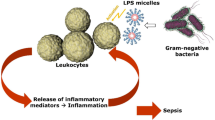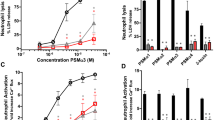Abstract
CONSIDERABLE diversity of opinion exists as to the sensitivity of hæmagglutination tests. The discrepancy in results may to some extent be attributed to technical differences. The factors influencing the reaction, the elution of endotoxin in vitro and the uptake by erythrocytes in vivo have been examined using a dehydrated endotoxin derived from S. typhi (TO–901). This powder consisted of 68.5 per cent ash, 7.8 per cent moisture, 1.6 per cent protein, 2.2 per cent lipids and, based on L-rhamnose hydrate as standard, 2.7 per cent rhamnose. If the method of calculation described by Webster et al. 1 is adopted the polysaccharide content is 14.3 per cent and the endotoxin approximately 20 per cent. The powder was dissolved in isotonic saline, heated to 56° C. for 30 min. and stored at 4° C. for at least 24 hr. before use. The solution had a slight buffer action, pH 7.2. Erythrocytes from healthy rabbits were washed and measured with the hæmatocrit. A volume of 0.2 ml. packed cells was used in most experiments.
This is a preview of subscription content, access via your institution
Access options
Subscribe to this journal
Receive 51 print issues and online access
$199.00 per year
only $3.90 per issue
Buy this article
- Purchase on Springer Link
- Instant access to full article PDF
Prices may be subject to local taxes which are calculated during checkout
Similar content being viewed by others
References
Webster, M. E., Sagin, J. F., Landy, M., and Johnson, A. G., J. Immunol., 74, 455 (1955).
Author information
Authors and Affiliations
Rights and permissions
About this article
Cite this article
BOKKENHEUSER, V., KOORNHOF, H. Interaction of Erythrocytes and Endotoxins. Nature 184, 109–110 (1959). https://doi.org/10.1038/184109b0
Issue Date:
DOI: https://doi.org/10.1038/184109b0
This article is cited by
-
Dissociation of Bacterial 0 Antigen from Rabbit Erythrocytes
Nature (1964)
-
Zum Nachweis spezifischer Antik�rper bei Dyspepsiecoli-Infektionen der S�uglinge mit Hilfe der indirekten H�magglutination
Zeitschrift f�r Kinderheilkunde (1962)
-
Antikörpernachweis bei Enterokokken-Infektionen des Menschen durch indirekte Hämagglutination
Zeitschrift für Hygiene und Infektionskrankheiten (1960)
Comments
By submitting a comment you agree to abide by our Terms and Community Guidelines. If you find something abusive or that does not comply with our terms or guidelines please flag it as inappropriate.



